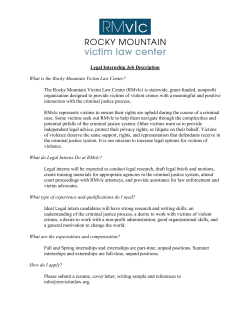
Nazi Persecution of Black People Mosaic – Victims
Nazi Persecution of Black People Mosaic – Victims of Nazi Persecution Nazi Persecution of Black People Racism towards black people was common in Europe and America in the 19th and early 20th centuries. Although such prejudices had a long history, they increased in this period with the development of Social Darwinism, a ‘pseudoscience’ which claimed that some racial groups were genetically superior to others. These ideas were used to justify European imperialism in the late 19th century when almost the whole of Africa was invaded and occupied by several countries. The Europeans who settled in the colonies often had extremely racist attitudes towards Africans, and the German empire was no exception. When Germany lost its colonies after the First World War, many Germans returned home and contributed to the growth of farright groups after 1918. At the same time, however, imperialism also led to the development of a black population in Germany. Some Africans, mainly young men, came to work or study in Germany and they were joined after World War I by others who had served the Germans as soldiers or officials. As a result, there were 20,000 to 25,000 members of the ‘Afrodeutsch’ community in interwar Germany. Germany’s black population included a significant number of people from mixed-race families. They were usually the children of either German colonialists who had married African women or of white women who had relationships with black people working in Germany. This shows that racism was not universal. In fact, although black people often encountered prejudice in the 1920s, some elements of black culture became popular in Germany, especially jazz music. In major cities such as Berlin black and white musicians (many of them Americans) performed to mainly white audiences. As Germany’s black population was small, it was not generally a major concern for racist groups such as the Nazi Party which emerged in the 1920s. When the farright did focus on non-whites, children of mixed-race origin were the main targets because they were seen as a threat to the ‘purity’ of the German race. This was particularly the case with the so-called ‘Rhineland Bastards’. After the First World War, the Rhineland region of western Germany was occupied by the British and French armies until 1930. Many of the French soldiers were from African colonies and were widely hated: many Germans believed it was humiliating for white people to be ordered around by black Africans. When some local women had relationships with the African soldiers, they were regarded as ‘traitors’ to Germany. Between 600 and 800 mixed-race children were born from these relationships and came to be seen by nationalists as a symbol of racial ‘disgrace’. It is not surprising, therefore, that the ‘Rhineland Bastards’ were the first black victims of the Nazis. In April 1933, the Nazi leader Hermann Göring ordered a study to count the numbers of these children. The results were passed to the Kaiser Wilhelm Institute of Anthropology which was one of the leading centres of so-called ‘racial science’ in Germany. It recommended that the children be sterilized to prevent their ‘alien blood’ from being passed on to other Germans. A law passed by the Nazis in 1933 had allowed the compulsory sterilization of people with supposedly hereditary illnesses, especially disabled people; it was now applied to the children from the Rhineland. Beginning in 1937, approximately 400 people, most of them young teenagers, were arrested and forced to undergo operations, often without anaesthetic, to prevent them having children. There is also evidence that some were victims of medical experiments. These policies were not applied to other black Germans, including mixed-race children from other parts of the country. However, they did face widespread discrimination which made it difficult to get jobs and they were forbidden to attend university. Some black people were able to make careers in the entertainment industry, taking small roles in films or performing in travelling circus-style shows of ‘traditional African dance and song’ which were partly intended to show the supposed ‘inferiority’ of black culture. A more openly racist policy was followed towards jazz, which the Nazis described as ‘degenerate music’. Jazz was presented as a ‘primitive’ form of music which had been exploited by American Jews to corrupt German society. It was therefore banned from public radio in 1935 and Nazi propaganda used racist images in an attempt to discredit it. Even though it became increasingly difficult to buy jazz records, some white teenagers, mainly in Hamburg and Berlin, continued to listen to jazz in clubs or their homes. In August 1941 more than 300 of these ‘Swingjugend’ (‘Swing Youth’) were arrested; some were eventually sent to concentration camps – essentially for listening to black music! Some black people, mainly American, British and French prisoners of war, also found themselves caught in the Nazi camp system. There is evidence that they were singled out for mistreatment or even murder by camp guards. In addition, some black soldiers were used as slave labourers by the German army. In 1943, a group of black German men were also sent to a labour camp near Berlin. Many of them had actually been conscripted for the army but had been rejected because of their colour; instead they were made to work as slaves for 72 hours a week. The fate of black people under the Nazis was little known for many decades after the Second World War. This was partly because most victims of the sterilization campaign were understandably reluctant to talk about their experiences in public. However, it also reflected a general lack of public interest in their case. Even today, Hitler’s black victims do not receive any compensation. Further materials will become available through the course of the joint project. For further information go to National Union of Teachers www.teachers.org.uk and Holocaust Educational Trust www.het.org.uk This brochure can be used with the following items Theodor WONJA MICHAEL Mosaic – Victims of Nazi Persecution What was ‘racial science’? Who has the right to decide who can have children? Copyright USHMM What does ‘Afrodeutsch’ mean? Mosaic – Victims of Nazi Persecution Designed and published by The Strategy and Communications Department of The National Union of Teachers – www.teachers.org.uk Origination by Paragraphics – www.paragraphics.co.uk – 8442/10/12 A slide for a lecture on genetics showing the child of a German woman and African soldier – 1936. Copyright USHMM Photo of Theodor: FilmInitiativ Köln e.V. (Sebastian Fischer) Designed and published by The Strategy and Communications Department of The National Union of Teachers – www.teachers.org.uk Origination by Paragraphics – www.paragraphics.co.uk – 8444/10/12
© Copyright 2025





















